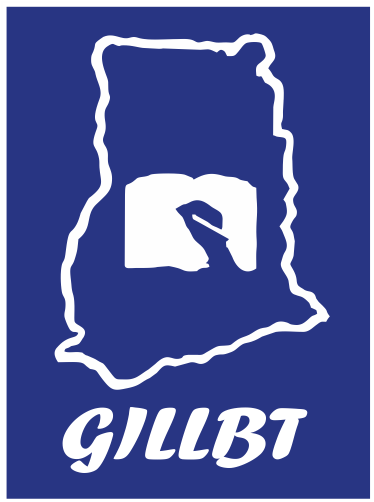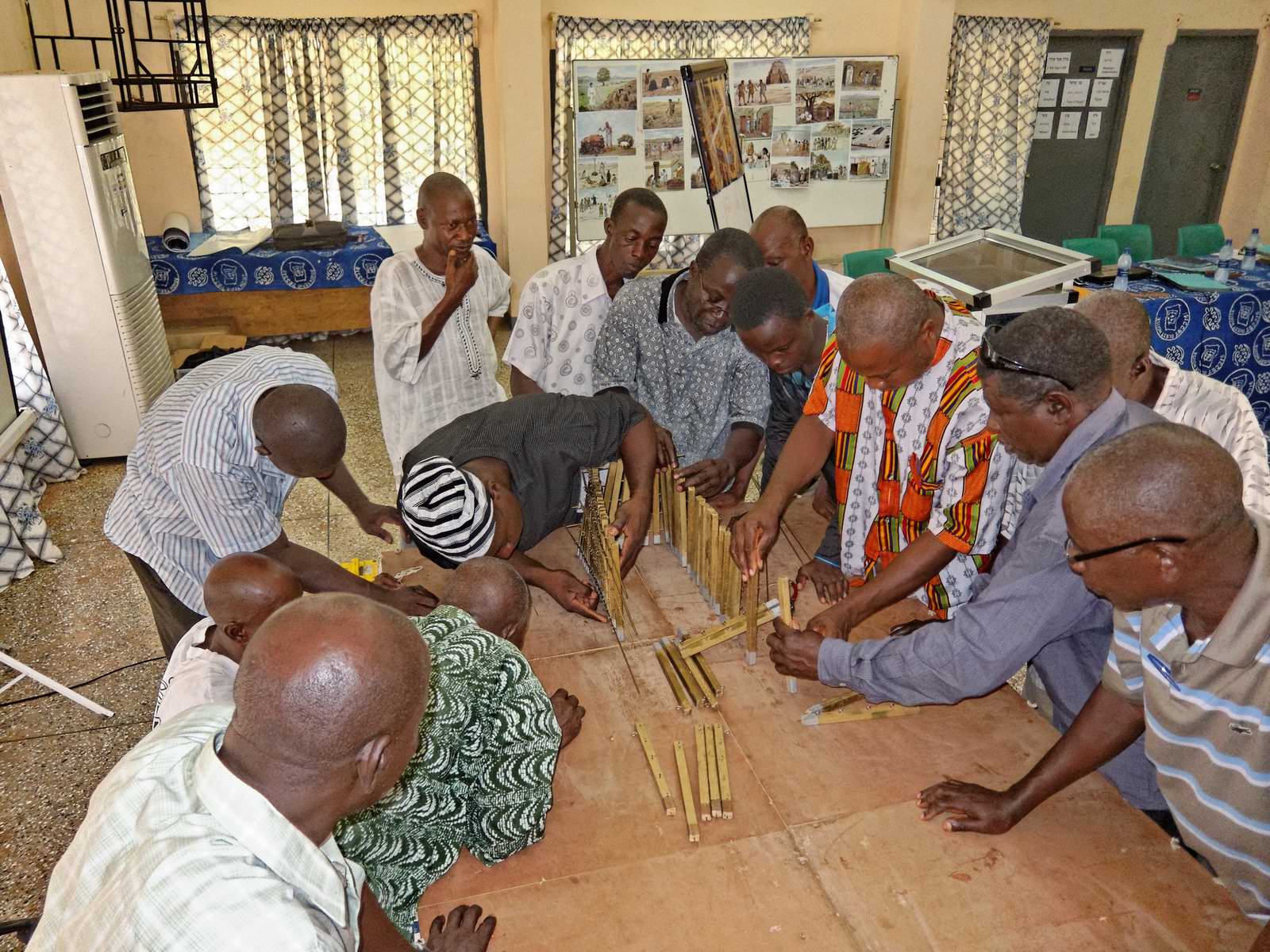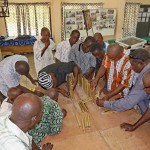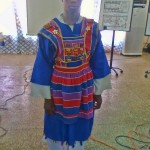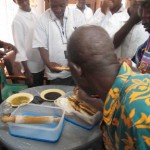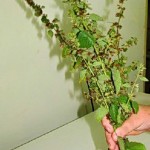The Bible presents its readers with a variety of themes, subjects, skills and personnel. This makes Bible translation interesting, exciting and also an arduous task. Due to its multifaceted nature, Bible translation requires the use of all our human faculties. It is therefore teamwork. This fits in perfectly with a Ghanaian proverb which says “wisdom is not the preserve of any one person.” As a result, every translation project taps into the skills of different people with the purpose of getting an accurate, clear and natural translation, one that is faithful to the original Hebrew or Greek text depending on the portion of Scripture being translated. The above scenario is exactly what happened seventeen years ago, GILLBT’s Translation Department organized a workshop on the book of Exodus for their translators. At that workshop, the translators constructed a model tabernacle which we read about in Exodus chapter twenty-five onwards. The construction was carried out under the guidance of a former GILLBT member, an expert craftsman and wood worker, Bob Schonveld and veteran translation consultants Bob and Nancy Schaeffer. The purpose then was to enable the translators get a hands on experience as well as a mental picture of the tabernacle so they could have a better understanding of the book in order to do a faithful translation. Back then, a number of GILLBT’S language projects translated either all or portions of the book of Exodus in their mother tongues.
Another workshop on the book of Exodus was organized from the 4th – the 15th of June 2012. Twenty translators from nine of GILLBT’s Old Testament projects and 7 Translation Consultants participated in the workshop. The pre-fabricated model of the tabernacle was brought for the translators to assemble so they could have a feel of what the tabernacle described in the Bible and its accessories looked like. Since most of the participants were not part of the construction seventeen years ago, they were very excited to see the model tabernacle which gave them clearer idea of what they read about in the Bible but have difficulty comprehending. In fact, a lot of people have confessed the difficulty used to have conceptualizing the descriptions found in the Bible. Seeing and touching the model tabernacle made so much difference in the understanding of Exodus chapters twenty-five to forty. According to the translators, the stories of the Passover, worship and sacrifices in the wilderness came so much alive to them. At last, what previously seemed like a myth, when they read about in the Bible became so practical, real, and comprehensible to the participants. Many thanks to Bob and Nancy Schaeffer, the workshop coordinators, for a good job well done! Their organizational abilities and powerful delivery of content attested to the in-depth preparations they made before the time.
This time round the organizers of the workshop however gave it a different twist from the one organized in 1995. Teaching a session in chapter three, the coordinators employed the use of drama to help the translators to get a feel of Moses encounter with God in the story of the burning bush. A spiritual lesson portrayed through the drama was how as humans we sometimes emphasize our weaknesses over above God’s desire to use us in spite for our frailties. An issue about translation that came up as the drama unfolded was the fact that an expression in one language does not necessarily express the same idea in another language, though that language may have the same expression. In Moses first encounter with God, we read about the story of a burning bush. It was discovered that the biblical or English idea of a bush is completely different from what most Africans refer to bush. For example here in Ghana often when one talks about a bush it refers to a large area of uncultivated land or a place away from the community’s living habitat. The idea of a bush referred to in Exodus chapter three is a single large plant. That was what was in flames but was not being eaten up. This was one of the lesson learnt that made the workshop beneficial to the participants.
A bunch of tropical plant believed to be a local equivalent of the hyssop plant was brought to serve as a visual aid so participants would know how to render hyssop in their translations. Hyssop is a plant mentioned in the Old Testament; it is used to sprinkle water or blood for religious cleansing (Ex. 12; Lev. 14: 4; Ps 51: 7). On seeing the plant, the translators, almost commented in unison: “Oh I know this plant, we have some in our area. It can even be used as a mosquito repellent. It can also be used as a paint brush”. These and other comments made by the translators revealed the wisdom in the showing of visuals . It was a common plant found in almost all the communities represented but never conceived of as a local substitute of hyssop.
- Translators constructed a model tabernacle, then read Exodus chapter forty while pointing to the different parts of the Tabernacle as a means of identifying the different items mentioned in the construction of the Tabernacle and its furnishings
- A Ghanaian workshop participant dressed in a replica of the high priests garments as they are described in Exodus.
- Translators taste unleavened bread they made during the workshop
- Hyssop – a plant important for sacrificial ceremonies as described in Exodus
Often times, some Christians equate the wafer served in Churches during communion service as unleavened bread. To correct this impression the coordinators of the workshop brought flour and olive oil for the translators to bake and taste the various kinds of unleavened bread mentioned in the books of Exodus and Leviticus ( see Ex. 12: 8; 17; 35:25; 13:3.) This was one of the interesting moments in translation, there was a lot of fun as the translators, all of whom were men, mixed, kneaded and portioned the dough into smaller sizes, then they rolled it out flat and finally baked it. After baking was complete, the translators who referred to themselves as “New Testament Levites and priests” enjoyed themselves to a snack of unleavened bread, olives and grapes.
Also, many different kinds of precious stones listed as part of the priestly garment were made available for viewing (Ex. 28; 39. The rational here is that hopefully, this will help translators find the local names for some of the stones as Ghanaian women use some to make beads for adornment. Thus, the coordinators graciously brought almost every unfamiliar article listed in the book to show to the translators so that we could have a mental picture of the items to help in producing a faithful translation. By so doing, the participants got to use all their five senses of sight, hearing, smell, taste and touch to bring home the import of the lessons. These and other activities made the workshop interesting and captivating such that the fatigue that sometimes characterises workshops was hardly felt. Before the participants were aware the two weeks had come to pass like a flash of lightening because of the exciting activities, lessons and insights gained on daily basis.
One may be wondering, since when did translation become a theatre art? The simple answer is that translation consultants, who also double as facilitators, endeavour to find every possible means to enable translators do a good translation, one that will have the same effect on their readers just as the original hearers were impacted by the Hebrew or Greek. Languages and cultures into which translations are being done are different from the ones into which the Bible was originally written. One important question every translator often asks is, “What was the author’s original intention? What was he saying to his original audience?” The translator aims to enable the new audience to understand that message, while remaining faithful to the historical facts. Contemporary readers of the Bible need to know relevant facts about the way people lived in Bible times, and about the historical situations in which the books of the Bible were written. For this reason, translators look for other supplementary ways of providing additional information, through such means as a glossary, introductions, illustrations, occasional footnotes. Often some of the relevant information about the biblical culture and historical situation can be provided by these means. This shows the relevance about the use of visuals in translation workshops and the translation process itself.
In conclusion, the notion that what people see, hear and touch leave a great impression on them motivated the use drama, as well as showing the priestly garments and the different types of stones mentioned in connection with the High priest’s garment. These and other tangible materials alongside other activities served as teaching aids to enable the translators catch a glimpse of what pertained in the biblical culture in order to represent as close as possible what the original author intended. Here are some pictures to help readers get a taste of what transpired at the just ended Exodus Workshop held by the Ghana Institute of Linguistics Literacy and Bible Translation.
